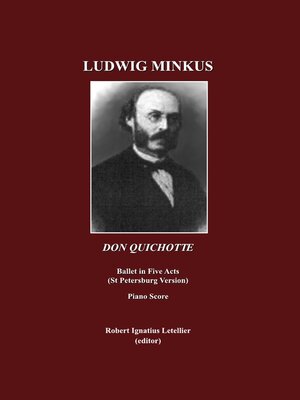Ludwig Minkus
ebook ∣ Don Quichotte; Ballet en cinq actes, avec prologue et épilogue, et onze tableaux, par Marius Peitpa
By Robert Ignatius Letellier

Sign up to save your library
With an OverDrive account, you can save your favorite libraries for at-a-glance information about availability. Find out more about OverDrive accounts.
Find this title in Libby, the library reading app by OverDrive.



Search for a digital library with this title
Title found at these libraries:
| Library Name | Distance |
|---|---|
| Loading... |
In 1868 the choreographer Marius Petipa planned his ballet Don Quixote for the Bolshoi Theatre in Moscow, and the Austrian composer Ludwig Minkus was invited to compose the music. The plot of Don Quixote was based on the adventures of Quiteria (known as Kitri in the ballet) and Basilio, which Petipa had developed from the second part of Miguel de Cervantes's novel (1605). The ballet was an enormous success, both in Moscow (14/26 December 1869) and in St Petersburg where it was represented at the Bolshoi Theatre on 9/21 November 1871 in an expanded version as Don Quichotte—with revised scenario and choreography that took cognizance of the more sophisticated expectations of the Imperial capital. Changes were made to the story, with a new fifth act in three scenes, for which Minkus wrote additional music. Don Quixote no longer regarded Kitri simply as his protégée, but now actually mistakes her for Dulcinea, and she appears as such in his Dream Scene. Provision was made for one ballerina to perform the double virtuoso role of Kitri and Dulcinea. The big classical scene for Don Quixote's dream was rewritten. Greater emphasis was now placed on this episode, where Kitri/Dulcinea was surrounded by a large corps de ballet and seventy-two children dressed as cupids. Alexandra Vergina was partnered by Basilio (Lev Ivanov), and supported by Pavel Gerdt in the last scene. The cast also included Timofei Stukolkine (Don Quixote), Nicholas Goltz (Gamache), and Alexei Bogdanov (Lorenzo).Don Quixote became established in the repertory, and its continued life on the Russian stage bears testimony to the appeal of its exuberance, "the life-asserting and life-loving nature of its dances" (Natalia Roslavleva). Generations of Russian ballet-masters and dancers preserved these dances in essence, and the ballet is still part of the Russian repertory, given today in all Russian and Siberian companies, in the Moscow version of Alexander Gorsky, in three acts and seven or eight scenes.Petipa's version of Don Quixote, with its life-affirming music by Minkus, has during the 20th century spread throughout the world, not least because of the work of Rudolf Nureyev who made a film version of the Australian Ballet production in 1971 that became very famous. It co-starred Robert Helpmann and Lucette Aldous, and made world history in being the first ballet to be produced with full film technique, so providing wider scope for imaginative handling of the famous story. Don Quixote has become the standard ballet version of the Cervantes tale, and one of the most popular pieces of the international repertory. Much of its emotional fervour is captured in the celebrated virtuoso Grand Pas de Deux for the wedding of Kitri and Basilio in the last scene. This piece, with a spectrum of feeling enshrined in its rapturous melodies and irresistible rhythmic élan, has assumed a life of its own as a concert piece in countless renditions wherever ballet is performed.The piano score of the St Petersburg version was published as Don Quichotte (St Petersburg: Theodore Stellowsky, c. 1882). This version is reproduced here.







